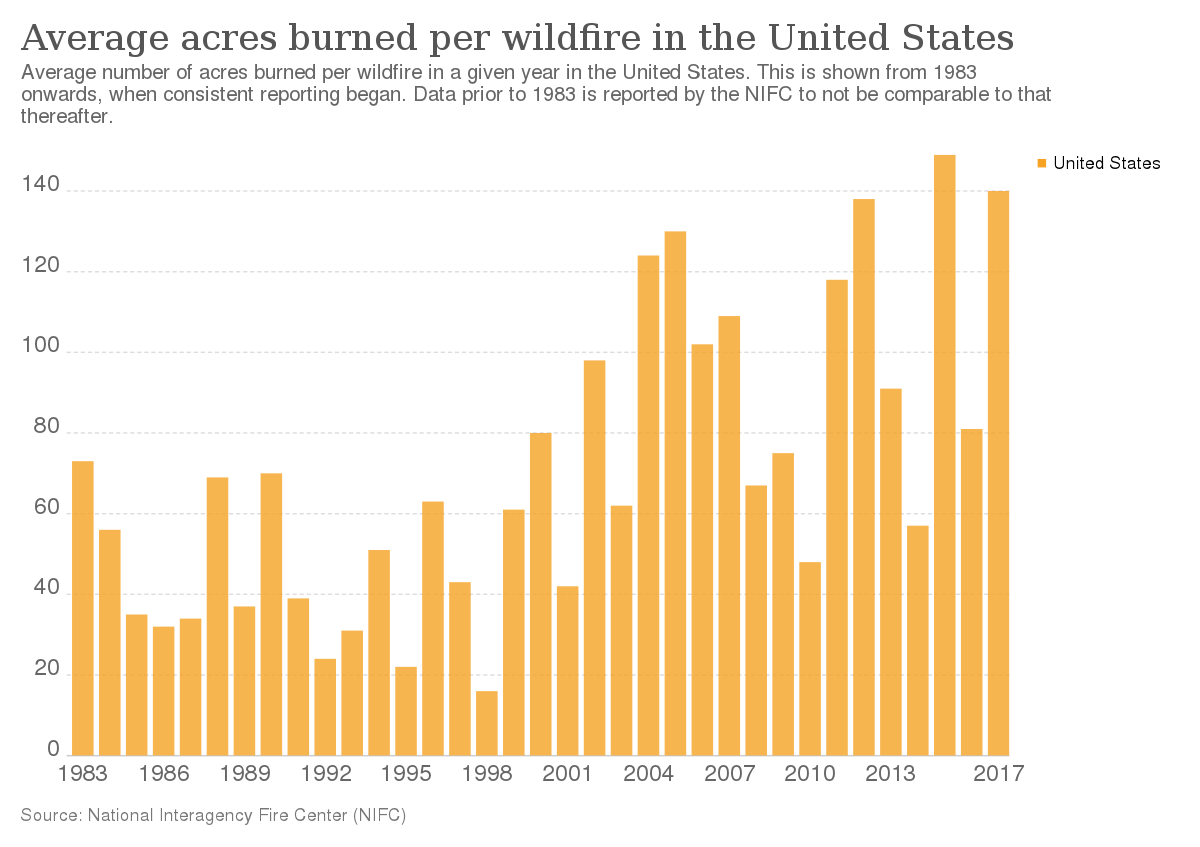On April 6, 2022, a prescribed fire driven by unusually strong spring winds jumped a control line northwest of Las Vegas, New Mexico. About two weeks later, the same dry winds rekindled embers from another nearby prescribed burn. Driven by 60-mile-per-hour (27-meter-per-second) winds with gusts reaching upwards of 80 miles per hour (36 meters per second), the two fires merged, and the Calf Canyon/Hermits Peak complex became the largest in New Mexico history. By the time the U.S. Forest Service (USFS) declared the fire contained in late August, almost 350,000 acres (141,600 hectares), an area greater than the size of Los Angeles, had burned. Nearly 1,000 structures were destroyed and thousands of people were displaced. Post-fire flooding killed multiple area residents and caused extensive damage.
Credit: Our World In Data via CC-BY-2.0
While fire is an integral part of Southwest forest ecosystems, a century of policies geared toward fire suppression in the American West that has led to a lack of diversity is colliding with climate change, upending the rules. Historically, a mature forest would burn, then, over time, return to a healthy, recognizable state. Today, however, an unprecedented decades-long drought, rising temperatures and massive insect outbreaks are hammering forests across the region, creating ideal conditions for megafires like the Calf Canyon/Hermits Peak inferno.
Thanks to climate change, experts say many southwestern forests destroyed by megafires may never return. Conditions across the region have become too hot and too dry for normal forest succession, and wildfires such as Calf Canyon/Hermits Peak are a catalyst for rapid change to an entirely different ecosystem. Forests can become fire- and flood-prone shrubland, and shrubland can become grassland dominated by invasive species such as cheat grass that likes to burn.
“All bets are off,” says Thomas Swetnam, Regents’ Professor Emeritus of Dendrochronology at the University of Arizona. “I hate to sound apocalyptic, but these are shocking, extraordinary events. The forests we had are not going to come back.”
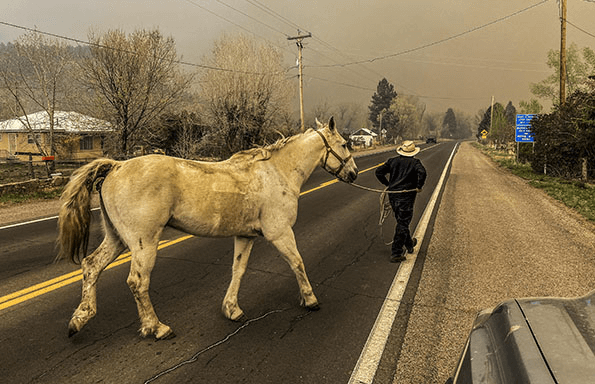
Residents of Mora, New Mexico, evacuate in May 2022 as the Calf Canyon/Hermits Peak fire crests a ridge less than a mile to the southeast. Forest-dependent communities across northern New Mexico have been dramatically impacted by recent megafires. Credit: Jim O’Donnell
These changes have a troubling impact on local wildlife and communities dependent on healthy watersheds for drinking water and irrigation.
Healthy forests, especially higher up in the watershed, increase groundwater storage, regulate stream flows and improve overall water quality by holding sediments and other contaminants. “These forest areas are our water storage system,” says Swetnam. “The only way to protect that system is with forest.”
Now, impacted communities, land managers and forest ecologists are all asking the same questions: What do we do next? Is forest restoration possible? Is it desirable? And how do we even define “forest restoration” in the age of climate change?
To answer those questions, researchers are looking at a range of potential solutions. Here’s a look at three that may prove applicable throughout the American West.
Follow the latest news and policy debates on sustainable agriculture, biomedicine, and other ‘disruptive’ innovations. Subscribe to our newsletter.
Where to focus
Matthew Hurteau, professor of biology at the University of New Mexico, says that restoring every square acre of burned forest after megafires is neither practical nor necessary.
Even a fire the size and ferocity of the Calf Canyon/Hermits Peak burn is not a complete ecological catastrophe. For much of the forest, it is an opportunity for rebirth and renewal. Most of the acreage burned in the spring of 2022 burned in what forest ecologists consider the “right way.” That is, the fire wasn’t hot enough to cause 100% tree mortality. Instead, the fire swept through, sticking low to the ground, clearing out the forest, laying down beneficial beds of fertilizing ash and triggering germination of native species adapted to fire. Just two months after the burn, many areas were covered in swaths of emerald as grasses and flowers rose through the ash. These areas, says Hurteau, don’t need active, human restoration. They just need time.
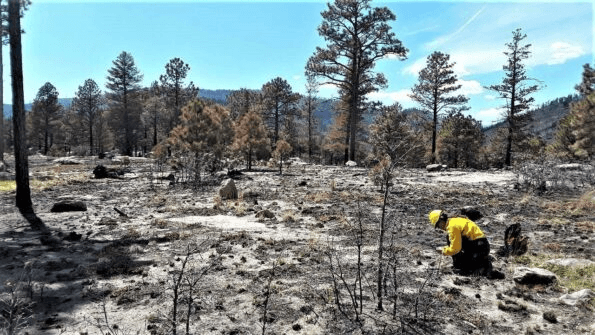
A U.S. Forest Service Burned Area Emergency Response soil scientist evaluates soil burn severity. Credit: InciWeb
Other locations, however, are cause for worry. Tens of thousands of acres burned so ferociously that every tree, shrub, flower and blade of grass is dead, including seeds that may have been waiting in the soil for years. “These high-intensity fires can sterilize the soil, making regeneration impossible. It’s these areas that will need our help,” says Hurteau. “We want to recapture as much of this forest as possible.”
To do so, Hurteau and his colleagues use a mathematical model they created to figure out where post-fire restoration will have the biggest impact and the greatest chance of success.
Utilizing 1 meter (3.3 foot) resolution digital elevation models, solar radiation indices and high-resolution topography models, Hurteau and team first identify areas where natural reseeding is likely and where trees will never be able to grow again. These they set aside. Next, they zero in on areas where reforestation is both important and possible but that were too severely burned to naturally reseed. These include wetter and shadier locations and higher elevation areas vital for watershed protection.
“Site specificity matters,” Hurteau explains. “In a drier zone that gets more sun we might do a mix of seedlings that includes drought-tolerant species like ponderosa pine, while a higher, wetter location might get a mix of other conifers.”
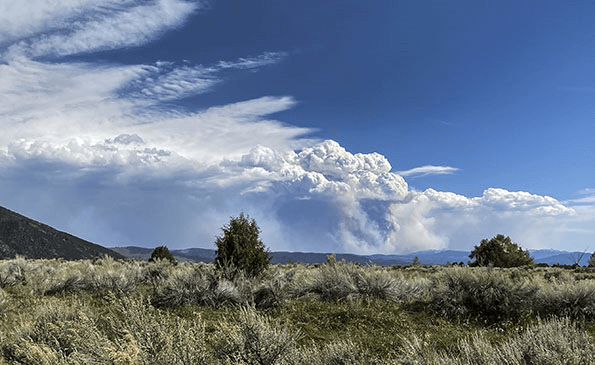
As harsh spring winds drove the Calf Canyon/Hermits Peak megafire, the fierce burn generated a pyrocumulous cloud towering tens of thousands of feet into the sky southeast of Taos, New Mexico. Credit: Jim O’Donnell
This is a process Hurteau calls “nucleation.” The idea is to create a nucleus of carefully selected seedlings suited for this harsh new environment. Researchers at the New Mexico State University John T. Harrington Forest Research Center in the northern New Mexico village of Mora select hardy, drought-tolerant species for restoration work in the highly impacted areas. The seedlings are drought-stressed in the nursery to acclimate and strengthen them, helping increase the chances they survive.
While a recent article in the journal Forest Ecology and Management found that, typically, survival rates for seedlings hovers around 20%, Hurteau says his team has been able to boost that rate to over 60% using the site-specific modeling tools. Instead of spending 10 to 15 years reforesting an area, 5 years might do it, Hurteau says.
“We might also consider bringing in non-natives to reforest key watershed areas instead of turning it over to fire-prone shrubs,” says Swetnam. Certain pines from the mountains of Mexico not only are adapted to hotter, drier conditions than those in New Mexico, Arizona and Colorado but also may be resistant to crown fires, which spread along the tops of trees. “Protecting our watersheds is vital going forward, and the best way to do that is with forest cover.”
New Mexico state forester Laura McCarthy is open to the idea. “It isn’t my first choice, but I say we follow the science and if the science tells us to do it, then let’s do it.”
A patchwork quilt
Returning diversity to southwestern forests is another tool forest ecologists say will reduce the possibility of future wildfires while protecting the headwaters of vital watersheds.
It is the higher elevation spruce-fir forests that keep McCarthy up at night. Much like the lower elevation ponderosa pine forests, spruce-fir ecosystems are naturally fire adapted, historically seeing stand-replacing fires about every 200 to 300 years.
Credit: Pacific Southwest Forest Service, USDA via CC-BY-2.0
These historic fires were destructive, but in the decades after such fires, stands of aspen rapidly filled in the burned areas, creating a natural spruce-fir ecosystem that was a mosaic of different aged spruce-fir stands, vast tracks of aspen and open meadows, somewhat like a patchwork quilt. That patchiness slowed and redirected subsequent fires, resulting in smaller burns that reinforced the pattern. Fires rejuvenated the forest diversity, creating a resilient system.
The historic fire regime of Southwestern forests began to change with grazing and wood gathering by local communities in the early 1800s. In 1910, federal forest management policy in the West turned toward total fire suppression, putting out every fire almost as soon as it began. This “10 a.m. policy” (meaning every fire should be suppressed by 10 a.m. the day following its initial report) resulted in massive swaths of landscape dominated almost exclusively by spruce-fir. The diversity that protected the overall system is gone and, without fire, the spruce-fir forest is taking over areas that were previously dominated by Douglas fir, making for a more flammable forest and further reducing diversity.
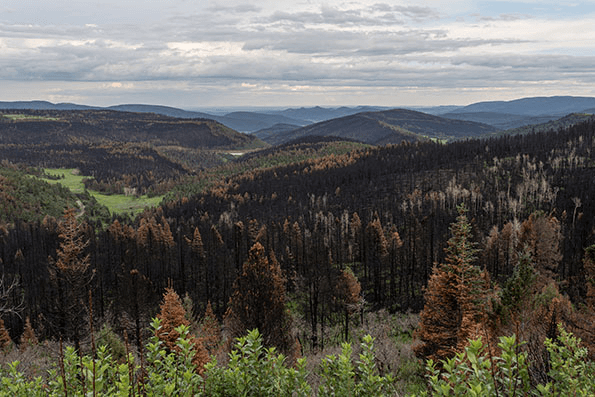
Burn scars from the Calf Canyon/Hermits Peak fire line the landscape. Credit: Matthew.kowal via CC BY-SA-4.0
“Continuous unbroken canopy becomes prone to highly destructive burns,” McCarthy says. “When you think about forests of the future, we want to lose the uniformity. Forest resilience is rooted in the patchiness, the diversity.”
To regain that diversity in the spruce-fir forests, the New Mexico State Forestry Division is working with both private landowners and the USFS on thinning and burning projects designed to encourage the return of aspen to the mix.
True climate change engineer
When Emily Fairfax, assistant professor of Environmental Science and Resource Management at California State University and Utah State University, pored over satellite images of landscapes that had seen massive wildfires in recent summers, she noticed a different type of landscape diversity. Green oases burst from the images, contrasting with the surrounding charred landscape. These were wetlands created by families of beavers damming local streams.
Where beaver dams existed prior to fires, the wetter landscape served as a fire break. After the fire, these wetlands served as a hub for landscape recovery.
Beavers are an important tool for future forest restoration, Fairfax says. A true climate change engineer, beavers construct dams that slow destructive floods often seen in burn scars, help replenish groundwater, filter ash that can harm fish populations and serve as seed banks to help regrow the surrounding ecosystem post-fire.
“It feels obvious,” Fairfax says. “If beavers were there before the fire, support them in recovery. If there weren’t beavers in the area, encourage them to repopulate the area after a fire. And the best part? Beavers work for free.”
Slow the impacts
The near-term impacts of climate change are irreversible. The question facing communities throughout the world is how to adapt. In the American Southwest, forest-dependent communities are thinking about how to protect their homes and watersheds in the face of a rapidly changing climate.
Credit: Our World In Data via CC-BY-3.0
“Natural systems are unstable,” Hurteau says. “Things move around and conditions change. That’s normal. But the rate of change these days is so rapid it is making it difficult, if not impossible, for forest species to adapt. We want to slow down the rate of change, slow down the climate impacts.”
